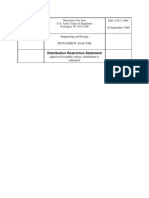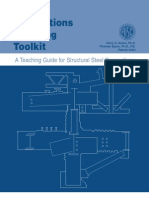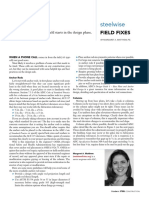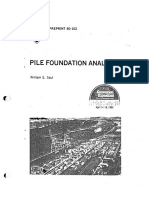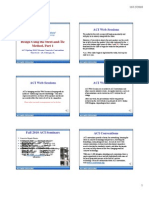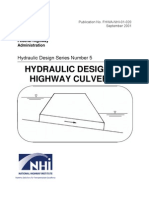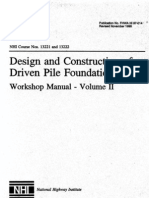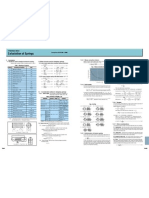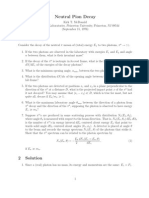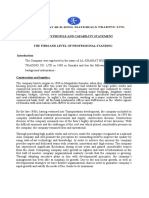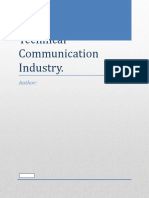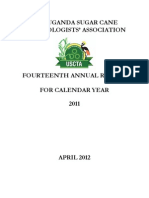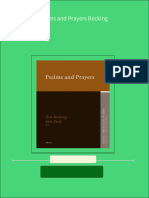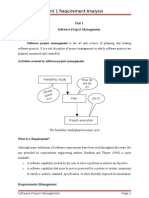SteelWise Anchor Rods
SteelWise Anchor Rods
Uploaded by
vCopyright:
Available Formats
SteelWise Anchor Rods
SteelWise Anchor Rods
Uploaded by
vOriginal Description:
Copyright
Available Formats
Share this document
Did you find this document useful?
Is this content inappropriate?
Copyright:
Available Formats
SteelWise Anchor Rods
SteelWise Anchor Rods
Uploaded by
vCopyright:
Available Formats
SteelWise
Anchor Rods
Can’t live with ‘em, can’t live without ‘em.
By Dan Swiatek and Emily Whitbeck with contributions from Victor Shneur, P.E.
Many common anchor rod problems are easier to avoid than you think!
n life there are a few things that are some guidelines on how you can prevent common challenges and easy solutions
I necessary evils, and anchor rods and
column base plate connections seem to
be one of them. These connections
have caused problems on many build-
ing projects, but by looking at the chal-
lenges that others have faced and show-
ing how these challenge have been
common problems in the design of
anchor rods and base plate connections,
and will help the designer to avoid
expensive field repairs and schedule
delays. Specifications and design guides
are already in place to aid in the design of
these connections for strength, but issues
for how to improve everyday anchor rod
and column base plate connection appli-
cations.
Dan Swiatek is a senior civil engineering
student at University of Illinois-Urbana-
Champaign and a former AISC intern. Emily
Whitbeck is a senior architectural engineering
successfully overcome, perhaps we can of constructability should be considered student at Penn State University and a for-
make the use of these important connec- on every project, to ease the construction mer AISC intern. Victor Shneur is chief engi-
tions more bearable. This article will give process. The following chart offers some neer with LeJeune Steel Co., Minneapolis.
Solutions to 17 Common Anchor Rod and Base Plate Dilemmas
Common Mistakes Easy Solutions
Specifying ASTM A325 or A490 anchor rods
Standard ASTM A325 and A490 bolts include Specify ASTM F1554 anchor rods
defined threaded length and heading require- This standard covers anchor rods with yield
1 ments and must be special ordered when strengths of 36, 55, and 105-ksi, in hooked,
their lengths exceed 9½ in. This can take up headed, and threaded/nutted options.
to four months.
Contact a local fabricator for availability
Even though most fabricators don’t make
Assuming that all material are available their own anchor rods, they will still know
It is possible that materials of different types about material availability or possible substi-
2 and sizes will not be readily available for your tutions. It will save money and time on your
project. project. If it is impossible to contact your fab-
ricator, ASTM F1554 grade 36 anchor rods
may be specified as a fail-safe option.
Reduce the variety of anchor rod settings
Specifying many different anchor rod set-
Specify one anchor rod setting and base plate
tings
for all exterior columns, and one for all inte-
Specifying a different anchor rod setting pat-
3 tern and base plate for every column size will
rior columns, based on the largest size. This
will be conservative for lighter columns, but it
end up leading to complications.
will greatly simplify detailing and installation.
Limit anchor rod sizes to one or two
Specifying many different anchor rod sizes This will be conservative in some cases but
Similarly to specifying settings, specifying will reduce installation mistakes. Try to make
4 many different sizes can lead to complica- sure the two sizes differ enough to avoid con-
tions. fusion and mistakes (at least 1/2-in. difference
in diameter).
December 2004 • Modern Steel Construction
Solutions to 17 Common Anchor Rod and Base Plate Dilemmas (cont’d.)
Common Mistakes Easy Solutions
Specify doubly symmetric settings
Specifying odd anchor rod settings Keep it simple by making anchor rod settings
Don’t specify settings that are seldom used if and base plates doubly symmetric about col-
5 you don’t have to. umn centerlines. Simplicity prevents prob-
lems.
Provide sufficient plan dimensions
Specifying base plates that are too small
This will allow for oversized holes and clear-
This provides no room for errors that are
6 likely to occur.
ances. Field fixes to enlarge holes or to add
plate washers will also be possible.
Use AISC anchor rod and base plate hole
Specifying standard oversized holes for
recommendations
anchor rods
Use the recommended hole sizes for base
Foundation inaccuracies are common. Often,
plates shown in AISC Design Guide 1, or in
7 the standard oversized hole dimensions used
Table 14-2 of the 3rd Edition Manual. This will
for bolts are not sufficient because there is
allow for even more tolerance in the founda-
not enough tolerance available.
tion for anchor rod placement. Make sure to
use a heavy plate washer over the hole.
Only provide grout holes with large plates
Specifying grout holes in small base plates If more than one hole is required, grout holes
If the smaller dimension is less than 24 in., need to be spaced approximately 18 in. apart.
8 do not specify grout holes. Grout holes should be 2 in. to 3 in. in diame-
ter.
Using anchor rods to transfer substantial Consider a shear key or an embedded plate
shear A shear key or embedded plate with welded
Anchor rods cannot be expected to transfer side plates can be used to transfer a large
9 shear forces due to their larger holes and the horizontal shear force from the column base
use of grout. to the foundation.
Welding all around the column and base Use one-sided fillet welds for gravity
plate columns
Column web-to-flange fillets provide very little A typical gravity column only requires a fillet
strength and may cause fabrication problems. weld at the flange. Columns in framing sys-
10 Welding that wraps around the flange toes for tems that experience uplift and shear will
a column and base plate connection creates require fillet welds on both sides of the flange
unwanted stress concentrations. and web.
Specifying a CJP groove weld
Specify a fillet weld if possible
If a simple fillet weld can resist uplift or shear,
Use a fillet weld on both sides of a joint than
then using a complete-joint-penetration
a CJP groove weld, if possible. Remember
11 groove weld for the connection between the that the fillet weld will benefit from the direc-
column and base plate is unnecessary and
tional strength increase factor.
expensive.
Modern Steel Construction • December 2004
Solutions to 17 Common Anchor Rod and Base Plate Dilemmas (cont’d.)
Common Mistakes Easy Solutions
Always using brackets at base plates
If the column is subjected to uplift, specifying Use thicker base plates
brackets or stiffener plates are not always This can eliminate the need for brackets or
12 necessary. These measures are not only stiffeners at base plates and will result in
expensive but also make field corrections much less labor to fabricate the columns.
impossible.
Specifying hooked anchor rods for axial
Use anchor rods that are headed or
loads
threaded at the end for axial loads
Because a hook can straighten and pull out,
Use rods that are headed or threaded at the
hooked rods should not be used for axial
13 loads. Exceptions include using them to pre- end with a nut for anchorage. Because of the
bigger shear cone, these have a greater pull-
vent overturning caused by erection loads or
out strength.
collisions during erection.
Tack weld this nut at the bottom
Welding the anchorage nut all around Since the only purpose of this weld is to keep
This includes both sides and the top. Welding the rod from turning while the top nut is tight-
14 the top can reduce the assembly strength. ened, a tack weld is more than sufficient. You
can also use a jamb nut.
Know the tolerances for anchor rod place-
Assuming precise placement per design
ment
The placement of both the concrete and the
ACI tolerances for anchorage are very liberal.
anchor rods cannot guarantee perfect eleva-
15 tion according to the design or erection Consider specifying the more stringent AISC
Code of Standard Practice tolerances for use
details.
by the concrete contractor.
Assuming anchor rods were installed per-
fectly Consider hiring a surveyor
It is very common for an anchor rod to be It might be a good idea to hire someone to
16 installed incorrectly. It is even more common inspect anchor rod installation, especially in a
for them to be damaged after installation by complicated or tightly-scheduled job.
other construction work.
Construction sequence should be specified
Assuming that walls will not be constructed
If there is a chance that the columns might be
It is very possible that walls or other con-
installed after a wall, make sure the correct
17 straints will be built before the column is order is specified before you design the
installed.
anchor rods and base plates.
December 2004 • Modern Steel Construction
You might also like
- Structural Defects Reference Manual For Low Rise BuildingsDocument295 pagesStructural Defects Reference Manual For Low Rise Buildingsv100% (1)
- Guide To Design of Anchors Bolts and Other Steel EmbedmentsDocument14 pagesGuide To Design of Anchors Bolts and Other Steel Embedmentsvinku950% (2)
- Designing HSS ConnectionsDocument8 pagesDesigning HSS Connectionsjarneberg100% (1)
- Steelwise: Designing Welds For Skewed Shear TabsDocument5 pagesSteelwise: Designing Welds For Skewed Shear TabsAdery Baltodano Monterrey100% (1)
- Guía de Fallas en Conexiones HSSDocument57 pagesGuía de Fallas en Conexiones HSSlcorao100% (3)
- Icbo Es Report-Er2078pDocument65 pagesIcbo Es Report-Er2078peltorro-tNo ratings yet
- Floor Deck CatalogDocument184 pagesFloor Deck CatalogJelean NavalNo ratings yet
- HILTI Volume 2 - Anchor Fastening Technical GuideDocument324 pagesHILTI Volume 2 - Anchor Fastening Technical GuideMike JuniorNo ratings yet
- Base Plate and Anchor Rod Design 2nd PDFDocument8 pagesBase Plate and Anchor Rod Design 2nd PDFAmol JdvNo ratings yet
- Ej 2020 - q1 Issue PDFDocument94 pagesEj 2020 - q1 Issue PDFgv Sathishkumar KumarNo ratings yet
- EM 1110-1-1904 - Settlement AnalysisDocument205 pagesEM 1110-1-1904 - Settlement AnalysisPDHLibrary100% (2)
- A Teaching Guide For Structural Steel ConnectionsDocument85 pagesA Teaching Guide For Structural Steel Connectionsv97% (68)
- WF To HSS Moment Connections R1 - FINAL PDFDocument1 pageWF To HSS Moment Connections R1 - FINAL PDFcecastaNo ratings yet
- Typical Steel Structual ConnectionDocument4 pagesTypical Steel Structual ConnectionS.Karthick100% (3)
- Vertical Bracing Connection For Rectangular HssDocument13 pagesVertical Bracing Connection For Rectangular HssEdris Salehi GolsefidiNo ratings yet
- Steel TipsDocument123 pagesSteel TipsEngr AxleNo ratings yet
- Steel Joists, Joist Girders and Hollow Structural Sections (HSS)Document55 pagesSteel Joists, Joist Girders and Hollow Structural Sections (HSS)jeffuangNo ratings yet
- HHS Connection DesignDocument3 pagesHHS Connection Designwii2001No ratings yet
- Shear Lug Verification Example 12Document1 pageShear Lug Verification Example 12Nasrul AdliNo ratings yet
- SJI SimpleConnectionsSimplified FINAL 05162018 Handout 1Document106 pagesSJI SimpleConnectionsSimplified FINAL 05162018 Handout 1Nemanja RandelovicNo ratings yet
- Designing HSS Connections PDFDocument4 pagesDesigning HSS Connections PDF112160rbcNo ratings yet
- Ej 2021 q1 IssueDocument82 pagesEj 2021 q1 IssueReab Simanth100% (1)
- Bolt To Hss (Long)Document1 pageBolt To Hss (Long)ronyNo ratings yet
- HSS Blind Structural Fasteners - May 2021Document7 pagesHSS Blind Structural Fasteners - May 2021David ArndtNo ratings yet
- Determination of Column Fixity at Column Bases PDFDocument71 pagesDetermination of Column Fixity at Column Bases PDFFWICIPNo ratings yet
- Design of Bearing Stiffeners in Cold Formed Steel C-SectionsDocument151 pagesDesign of Bearing Stiffeners in Cold Formed Steel C-SectionsFabio Saraiva Box100% (1)
- Keeping Fillet Welding in CheckDocument2 pagesKeeping Fillet Welding in CheckdavidNo ratings yet
- AISC Connection Teaching AISC ToolkitDocument85 pagesAISC Connection Teaching AISC Toolkitoscar100% (2)
- Cisc Vs AiscDocument11 pagesCisc Vs Aiscanon_326950184100% (1)
- AISC Design Guide 31 - Castellated and Cellular Beam Design PDFDocument117 pagesAISC Design Guide 31 - Castellated and Cellular Beam Design PDFchristian halim100% (1)
- Software Verification: AISC-360-10 Example 001Document9 pagesSoftware Verification: AISC-360-10 Example 001Davico HernandezNo ratings yet
- AISC Design Fabrication and Erection of Steel Building Edge Form - 2002 PDFDocument24 pagesAISC Design Fabrication and Erection of Steel Building Edge Form - 2002 PDFhoustonhimselfNo ratings yet
- s3l Nelson StudDocument1 pages3l Nelson StudPau NaipilNo ratings yet
- Sherman - Extended Shear TabsDocument148 pagesSherman - Extended Shear TabsRohan KarandeNo ratings yet
- Ssec Tip 100Document51 pagesSsec Tip 100Amjad PervazNo ratings yet
- AISC - Design Guide 10 - Errata - Erection Bracing of Low - Rise Structural Steel Buildings PDFDocument2 pagesAISC - Design Guide 10 - Errata - Erection Bracing of Low - Rise Structural Steel Buildings PDFapuhapuh_153349No ratings yet
- Hss-Wide Flange External Diaphragm ConnectionDocument5 pagesHss-Wide Flange External Diaphragm ConnectionJomo-Rhys Gilman100% (1)
- Purlin Design To AISI LRFD Using Rational Buckling Analysis 09007dcc809cfddfDocument14 pagesPurlin Design To AISI LRFD Using Rational Buckling Analysis 09007dcc809cfddfEmrE GöktuĞ100% (1)
- Base Plates and Anchor Rods - Steel Design AISCDocument3 pagesBase Plates and Anchor Rods - Steel Design AISCpenneng33% (3)
- Designexample04 PDFDocument159 pagesDesignexample04 PDFmtNo ratings yet
- 2014.01.08 - Moment Connections To HSS ColumnsDocument49 pages2014.01.08 - Moment Connections To HSS ColumnsUALU33389% (9)
- Wind Loading in Steel Joist Design PDFDocument95 pagesWind Loading in Steel Joist Design PDFnitroxx7No ratings yet
- The Development of A New Design Procedure For Conventional Single-Plate Shear ConnectionsDocument12 pagesThe Development of A New Design Procedure For Conventional Single-Plate Shear ConnectionsMiguelNo ratings yet
- Design Guide Joist Girder Rev4 Final 11sep06Document60 pagesDesign Guide Joist Girder Rev4 Final 11sep06Тодор Илиески0% (1)
- AISC/MBMA Steel Design Guide No. 16Document14 pagesAISC/MBMA Steel Design Guide No. 16อภิรักษ์ มานะกิจศิริสุทธิ100% (3)
- Standard For Steel Roof Deck: CSSBI 10M - 08 October 2008Document8 pagesStandard For Steel Roof Deck: CSSBI 10M - 08 October 2008Anonymous P73cUg73LNo ratings yet
- AISC Design Guide 10 Revisions-And-Errata-List PDFDocument2 pagesAISC Design Guide 10 Revisions-And-Errata-List PDFCarlo DizonNo ratings yet
- Steelwise PDFDocument4 pagesSteelwise PDFJagatheesh RadhakrishnanNo ratings yet
- Design of Unstiffened Extended Single Plate Shear ConnectionsDocument14 pagesDesign of Unstiffened Extended Single Plate Shear ConnectionsGonzalo ContrerasNo ratings yet
- Design of Unstiffened Extended Single-Plate ShearDocument15 pagesDesign of Unstiffened Extended Single-Plate ShearM. Murat ErginNo ratings yet
- FAQs About Headed Reinf Bars - ETN-M-3-14Document8 pagesFAQs About Headed Reinf Bars - ETN-M-3-14MukarramuddinNo ratings yet
- Tips & More: For Economical DesignDocument4 pagesTips & More: For Economical DesignLuis Horacio Martínez MartínezNo ratings yet
- MSC October 2011 PDFDocument8 pagesMSC October 2011 PDFYan Naung KoNo ratings yet
- Substation Structures, Valmont NewmarkDocument111 pagesSubstation Structures, Valmont Newmarkdavidfc26No ratings yet
- Applications of Pretensioned Anchor Rods in Industrial FacilitiesDocument10 pagesApplications of Pretensioned Anchor Rods in Industrial FacilitiesAndré Luiz NogueiraNo ratings yet
- Pre-Fabricated Punching Shear ReinfDocument4 pagesPre-Fabricated Punching Shear ReinfJose ManjooranNo ratings yet
- Steel Interchange: Modern Steel's Monthly Steel Interchange Is For You!Document2 pagesSteel Interchange: Modern Steel's Monthly Steel Interchange Is For You!Andres CasadoNo ratings yet
- Principles and Practices of Stud Welding: State-Of-The-Art PaperDocument13 pagesPrinciples and Practices of Stud Welding: State-Of-The-Art Paperalbert limantonoNo ratings yet
- Si 5 2014 PDFDocument2 pagesSi 5 2014 PDFhector diazNo ratings yet
- Steel Tips 1Document40 pagesSteel Tips 1banbanio4680% (5)
- AISC Design GuidesDocument3 pagesAISC Design GuidesDharmendu00780% (5)
- 21 - Design and Detailing of Base Plates To Steel ColumnsDocument4 pages21 - Design and Detailing of Base Plates To Steel Columnsmopoboc462No ratings yet
- C InSights Colarusso Nov11Document1 pageC InSights Colarusso Nov11tsuregiNo ratings yet
- Doe Standard: Hoisting and Rigging (Formerly Hoisting and Rigging Manual)Document403 pagesDoe Standard: Hoisting and Rigging (Formerly Hoisting and Rigging Manual)vNo ratings yet
- Singapore. Building and Construction Authority-Structural Precast Concrete Handbook - Building and Construction Authority (2001) PDFDocument174 pagesSingapore. Building and Construction Authority-Structural Precast Concrete Handbook - Building and Construction Authority (2001) PDFShamim Ahsan ZuberyNo ratings yet
- Moving Load EquationsDocument6 pagesMoving Load EquationsvNo ratings yet
- RRW 410 FDocument90 pagesRRW 410 FvNo ratings yet
- WRN Oct08Document88 pagesWRN Oct08vNo ratings yet
- ACB Design Manual Third EditionDocument112 pagesACB Design Manual Third EditionvNo ratings yet
- Cálculo Studs PDFDocument19 pagesCálculo Studs PDFCristiana FurlanNo ratings yet
- Stress Analysis of Concrete PipeDocument17 pagesStress Analysis of Concrete PipeAli ÖztürkNo ratings yet
- Design of Lifting and Tailing LugsNetsc001Document30 pagesDesign of Lifting and Tailing LugsNetsc001Tshilidzi Irene Netselo100% (1)
- PILE Foundation Analysis - ASCE William Saul-1980 - SearchableDocument22 pagesPILE Foundation Analysis - ASCE William Saul-1980 - Searchablev100% (1)
- FHWA Geotechnical Engineering Circular No. 6 - Shallow FoundationsDocument296 pagesFHWA Geotechnical Engineering Circular No. 6 - Shallow FoundationsvNo ratings yet
- Foundations For CompressorsDocument7 pagesFoundations For Compressorsv100% (1)
- Project: Client: Engineer: Remarks:: Your Company Name HereDocument5 pagesProject: Client: Engineer: Remarks:: Your Company Name HerevNo ratings yet
- Strut and Tie Part 1Document14 pagesStrut and Tie Part 1Turcu Catalin NicolaeNo ratings yet
- Parametric Bay Studies V4 - 0 (AISC)Document20 pagesParametric Bay Studies V4 - 0 (AISC)v100% (1)
- Hydraulic Design of Highway CulvertDocument367 pagesHydraulic Design of Highway CulvertMohammad Saleem Zahidi100% (7)
- Design and Construction Driven Pile Foundation Vol 2Document450 pagesDesign and Construction Driven Pile Foundation Vol 2v91% (11)
- Articles From Wire Reinforcement InstituteDocument107 pagesArticles From Wire Reinforcement Institutev100% (1)
- Basic Vibration TheoryDocument11 pagesBasic Vibration TheoryvNo ratings yet
- A Fatigue Primer For Structural EngineersDocument139 pagesA Fatigue Primer For Structural Engineersv100% (3)
- COMPREHENSIVE DESIGN Example For PRESTRESSED CONCRETE (PSC) GIRDER SUPERSTRUCTURE BRIDGE WITH COMMENTARY SI UNITSDocument384 pagesCOMPREHENSIVE DESIGN Example For PRESTRESSED CONCRETE (PSC) GIRDER SUPERSTRUCTURE BRIDGE WITH COMMENTARY SI UNITSvNo ratings yet
- Design Guide For Highway Noise BarriersDocument97 pagesDesign Guide For Highway Noise Barriersv100% (1)
- Design and Construction of Driven Piles Vol 1Document830 pagesDesign and Construction of Driven Piles Vol 1v100% (10)
- Calculation of SpringsDocument1 pageCalculation of Springsv100% (1)
- 15.1 Explain The Factors That Causes Deviation.: EarthDocument7 pages15.1 Explain The Factors That Causes Deviation.: EarthREYNALD TEJERONo ratings yet
- Pi On DecayDocument5 pagesPi On DecayHarrainy ZhouNo ratings yet
- Products Price ListDocument8 pagesProducts Price ListDanarko Niliestyo100% (1)
- Organazing and Staffing Case Study 2Document5 pagesOrganazing and Staffing Case Study 2Kurl Vincent GamboaNo ratings yet
- Emotional Intelligence in The Energy Sector - Part 2Document2 pagesEmotional Intelligence in The Energy Sector - Part 2Neural Network ConsultingNo ratings yet
- Senior Human Resources Manager in United Arab Emirates Andries ZeemanDocument3 pagesSenior Human Resources Manager in United Arab Emirates Andries ZeemanAndriesZeemanNo ratings yet
- Basic Tools and Materials in Macrame and BasketryDocument32 pagesBasic Tools and Materials in Macrame and BasketryREYNALDO BAJADO100% (2)
- Rovalve SB 1700 SST Knife Gate Valve 2 - 24 InchDocument4 pagesRovalve SB 1700 SST Knife Gate Valve 2 - 24 InchCapacitacion TodocatNo ratings yet
- Alkhairat Company Profile (Final) Kii LamaadDocument28 pagesAlkhairat Company Profile (Final) Kii LamaadAbdulkadir HusseinNo ratings yet
- Mbus To Modbus Converter PDFDocument4 pagesMbus To Modbus Converter PDFAnsar AwanNo ratings yet
- Cash Box Top Singles 2 - 04 - 50Document2 pagesCash Box Top Singles 2 - 04 - 50David SkidgelNo ratings yet
- CombustionDocument17 pagesCombustiontabanalindiweNo ratings yet
- Fenton Stream Function TheoryDocument12 pagesFenton Stream Function TheoryElendu Emmanuel ChigozieNo ratings yet
- Common Mistakes CompilationDocument9 pagesCommon Mistakes CompilationAdamNo ratings yet
- SE Current Monitoring Series H908-S6: DangerDocument3 pagesSE Current Monitoring Series H908-S6: DangerIsrael AldabaNo ratings yet
- E Show Preview ITE 2023 CompressDocument10 pagesE Show Preview ITE 2023 Compresszackroo25No ratings yet
- Essay - Latest Trends in Technical WritingDocument4 pagesEssay - Latest Trends in Technical Writingkumaryadav567No ratings yet
- First Things First ManifestoDocument5 pagesFirst Things First ManifestoGiliam GanzevlesNo ratings yet
- The 14th USCTA Annual Report 2011Document59 pagesThe 14th USCTA Annual Report 2011s.sabapathyNo ratings yet
- Case Solutions For Case Studies in Finance Managing For Corporate Value Creation 6th Edition by BrunerDocument12 pagesCase Solutions For Case Studies in Finance Managing For Corporate Value Creation 6th Edition by Brunerbiwithse7en0% (1)
- BIMA BBS RegisterDocument47 pagesBIMA BBS Registeraminamin.200029No ratings yet
- Huawei SingleSDB V100R003C01 IMS HSS Feature DescriptionDocument74 pagesHuawei SingleSDB V100R003C01 IMS HSS Feature DescriptionaranibarmNo ratings yet
- 4 Examination of Customers Intention Anita AliDocument8 pages4 Examination of Customers Intention Anita AliDinda caesarliNo ratings yet
- 1 - Neutriherbs Catalog 2020v1Document37 pages1 - Neutriherbs Catalog 2020v1Yaseer Assot AllyNo ratings yet
- Pitting Trenching Activty eDocument2 pagesPitting Trenching Activty eFARHA NAAZNo ratings yet
- ACON - SFF TransceiverDocument1 pageACON - SFF TransceiverClaudiney BricksNo ratings yet
- Week 13 Topic 9 Lecture Notes - Other Assurance ServicesDocument22 pagesWeek 13 Topic 9 Lecture Notes - Other Assurance Servicessanjeet kumarNo ratings yet
- Psalms and Prayers Becking All Chapter Instant DownloadDocument84 pagesPsalms and Prayers Becking All Chapter Instant Downloadbijevaraadom85100% (3)
- Coc Exam 2015 For Midwifery Part 1Document24 pagesCoc Exam 2015 For Midwifery Part 1xviii zedo100% (3)
- Unit 1 Requirement Analysis: Unit 1 Software Project ManagementDocument10 pagesUnit 1 Requirement Analysis: Unit 1 Software Project Managementvvv1991No ratings yet










